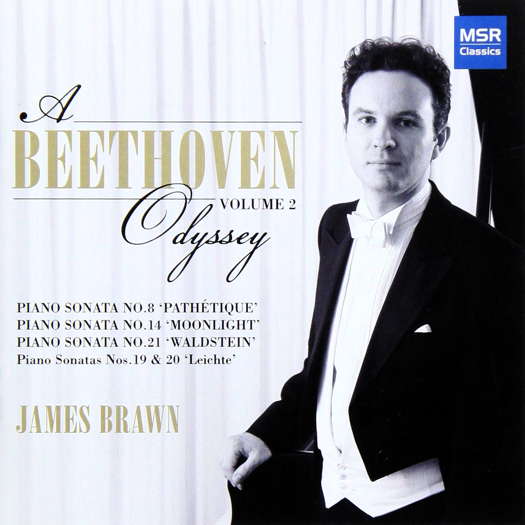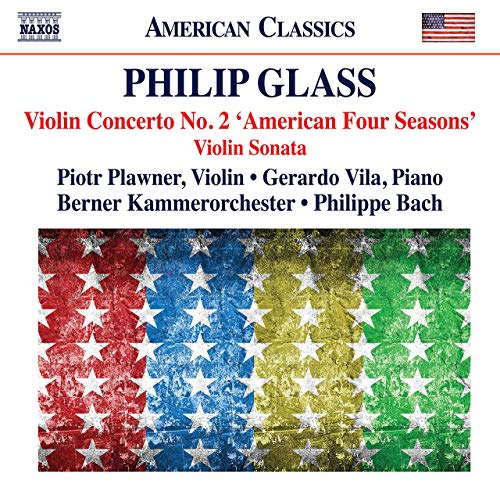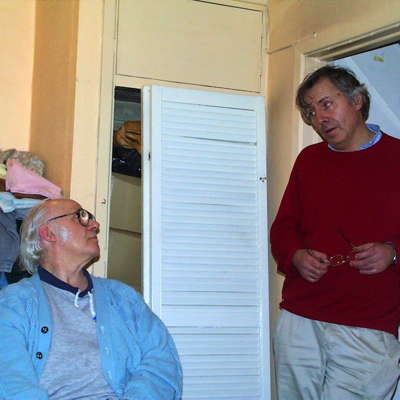 SPONSORED: CD Spotlight. Perfect Indeed - More Beethoven from James Brawn, recommended by Andrew Schartmann.
SPONSORED: CD Spotlight. Perfect Indeed - More Beethoven from James Brawn, recommended by Andrew Schartmann.
All sponsored features >>

Baroque Minimalism and 21st Century Minds
ONA JARMALAVIČIŪTĖ listens to
music for violin by Philip Glass
'The magic of this iconic figure in American music is still aweing listeners.'
In Bern, Switzerland, in December 2018, a unique CD was recorded, presenting exclusively works for violin by the father of the movement which others, against his will, call minimalism - Philip Glass. This satisfying recording celebrates the continuing international popularity of the minimalist style and the durable appeal of Glass and his characteristic arpeggiated texture. The composer manipulates his concept of 'additive process' or 'music with repetitive structures' into a very personal compositional trend and the pieces on this recording - the Violin Concerto No 2 'American Four Seasons' and the Sonata for Violin and Piano - are drawn towards this standard, at the same time exceling on a broader emotional complexity.
A Polish soloist of rare excelence, Piotr Pławner, brings all of his technical finesse and subtle interpretive instincts to turn these pieces into a superb performance. The violinist reaches international acclaim as a first-prize winner of the Tenth H Wieniawski International Competition and the Munich-based ARD Competition in 1995. To this day, with a Tomasso Balestrieri violin in his hands, he has performed in nearly all European countries and in Arab states. With a strong presence in both Poland and Western Europe, he has specialized in the music of Polish composers, often performing neglected works. Pławner's virtuosity mastering repertoire of different epochs has really prepared him for the interpretational responsibility for Glass and Vivaldi works for violin.
Pławner often plays modern works from a variety of musical directions. This time, learning these Glass masterpieces, he makes his interpretation unique and it flows well with high quality well-miked sound. He meets every presented challenge with apparent ease using subtle interpretive instincts. His recording partners - pianist Gerardo Vila and synthesizer player Annika Guy - blend well in both Baroque and postmodernist music. Gerardo Vila accompanies Pławner's violin through all the technical challenges of the piano part. Annika Guy brings alive the keyboard part rounding out the performance. Leading one of the largest orchestras in Switzerland - the Bern Chamber Orchestra - is Philippe Bach - a versatile operatic and symphonic conductor, working in musically diverse countries. Even as a world-renowned conductor, he is remembering his Swiss roots and becoming the vital force in bringing this Bern Chamber Orchestra recording to life.
Listen — Philip Glass: Movement 1 (Violin Concerto No 2)
(track 2, 2:00-2:54) © 2020 Naxos Rights (Europe) Ltd :
Although characteristically Glass' own, the pieces on the CD evoke and draw on the musical past. The main work on the recording is the Glass second violin concerto (2009) in the baroque violin music tradition, and its lasting value as the birthplace of a modern violin repertoire. The so-called 'American Four Seasons' is seen as a sequel, programmed together with the Vivaldi classic. Glass composed the work only after years of exchanges with violinist Robert McDuffie, who had this idea of the 21st century's violin concerto as a companion to Vivaldi's The Four Seasons. The piece refers to general Baroque texture and concerto grosso prototype, using a synthesizer instead of a harpsichord as basso continuo. In this way, bringing Glass' arpeggios and ostinato figures into a different context, the piece suggests the common ground between minimalistic and baroque repertoire. It makes Vivaldi into the world's first minimalist and 'America's Vivaldi', Philip Glass, into a baroque composer of the 21st century. Even though there is no mistaking Glass for Vivaldi, Baroque and minimalism may be closer than we expect. Both are precise and improvisational at the same time. The full circle between the eighteenth and 21st centuries is playful, filled with chugging ostinati, repetition and pleasant melodies.
Glass' Second Violin Concerto is structured around four orchestrally based movements and four solo cadenzas for violin, which can be extracted as a separate work. The first solo is called 'Prologue', and the other three are named as songs.
Listen — Philip Glass: Song No 1 (Violin Concerto No 2)
(track 3, 0:00-1:00) © 2020 Naxos Rights (Europe) Ltd :
It is double in length, and also further developed in its emotional and expressive scope when compared it his first violin concerto. The Second Violin Concerto adds to Vivaldi's famous work, a framework of a Baroque concerto. The piece seems a peculiarly aleatoric, open-ended version of program music, since the composer leaves the listener to place each of the four seasons themselves and is open to different interpretations. Therefore the fast tempo in the first movement could be a reference to the Autumn winds, the vigor of Summer, the intenseness of Winter, as well as the refreshing advent of Spring. Between the ever changing seasons, there are a number of solo pieces for the violinist. The range of virtuosic challenges in this composition is inspiring. The first movement is in particular highly virtuosic, the slow second movement constitutes the work's emotional core.
Listen — Philip Glass: Movement 2 (Violin Concerto No 2)
(track 4, 7:01-7:58) © 2020 Naxos Rights (Europe) Ltd :
In the third and fourth movements, a sense of 'subtle rhythmic seduction' builds. The driving energy of the final movement builds into waves of rhythm and harmony.
The second piece presented on the CD is the Philip Glass Violin Sonata (2008). This more conservative composition takes inspiration for its melodic and harmonic figures from other sonatas - those composed by Brahms, Fauré and Franck. The piece has an unusual beginning and a meditative energy throughout.
Listen — Philip Glass: Movement 1 (Sonata for Violin and Piano)
(track 9, 0:00-0:48) © 2020 Naxos Rights (Europe) Ltd :
The first movement feels dark and anxious, and the lyrical second part is mellow and dreamy, somewhat resembling such composers as Bartók and Prokofiev. The finale is brilliant and show-stopping, although very challenging. The pulsating accompaniments underpinning the extended melody in the sonata characterizes Glass' music, based on harmonic progressions as structural elements.
Listen — Philip Glass: Movement 2 (Sonata for Violin and Piano)
(track 10, 6:26-7:20) © 2020 Naxos Rights (Europe) Ltd :
It is incredible to witness that the importance of minimalism and the unique personal style of Philip Glass is so well received and relevant even after half the age that it was descovered. The magic of this iconic figure in American music is still aweing listeners. Not every avant garde style can be happy about its lasting influence. Many are criticizing his trademark monumentalist-minimalist style as easy to mimic, or primitive; the simplicity itself makes it stand out and bring original colour in the same way Vivaldi's music was seen as showy, vulgar and facile. The fact that individual musical style of Philip Glass is so simple yet profound and difficult to imitate makes him the biggest composer of our time. It looks like his succsess is not vanishing anytime soon. We hope his music will be as vital for future generations, as that of Vivaldi or Brahms.
Copyright © 20 June 2020
Ona Jarmalavičiūtė,
Vilnius, Lithuania

CD INFORMATION: PHILIP GLASS: AMERICAN FOUR SEASONS
FURTHER INFORMATION: THE AMERICAN FOUR SEASONS
FURTHER INFORMATION: PHILIP GLASS



